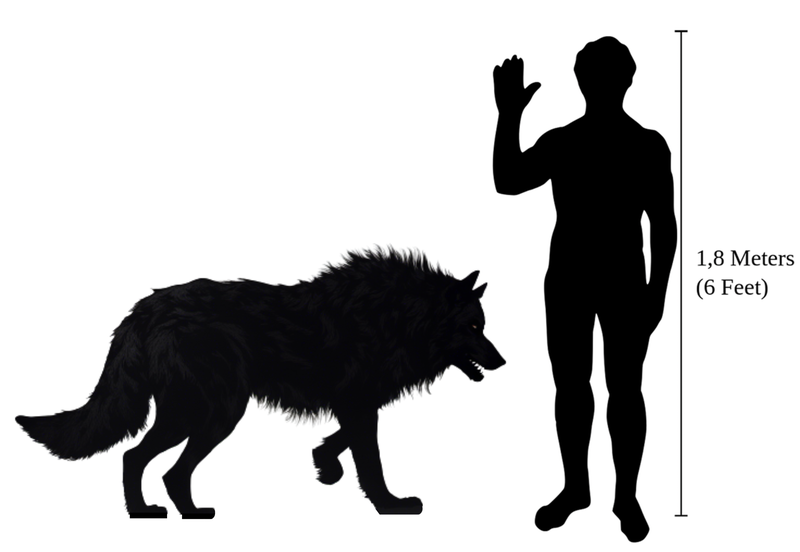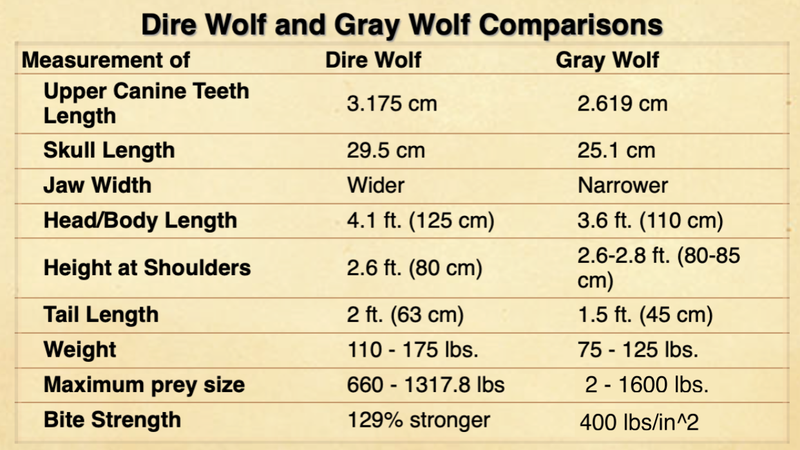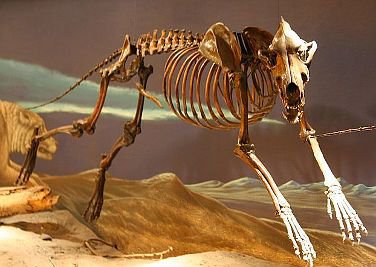Dire Wolf Appearance

.
The dire wolf, an iconic creature renowned for its appearance in the cultural phenomenon of Game of Thrones, has captured the imagination of many. But how did the dire wolf compare in size to its modern-day counterpart, the gray wolf? Let's delve into the dimensions and distinctions between these two fascinating canids.
Researchers only feel certain about the bone and body structure of the dire wolf’s appearance. Each year, they uncover thousands of dire wolf skeletons encased in our Earth’s own historical museum and each one reveals some aspect of the dire wolf’s appearance. These complete and well-preserved skeletons can tell us about the size, weight and overall shape of the dire wolf. They cannot, however, determine ear height, typical coat coloring, length and texture of fur, or eye color, of which we can only speculate. However, through Isotopic Analysis we can learn about the dire wolf’s eating habits. This affects how the dire wolf can use its massive body to hunt and thus gain the build needed to maintain such a diet. By analyzing the diverse body structure of domesticated dog breeds, we can speculate about other habits that may have influenced the dire wolf’s appearance.

.
The dire wolf, scientifically known as Aenocyon dirus, exhibited proportions that bear resemblance to two contemporary North American wolves: the Yukon wolf (Canis lupus pambasileus) and the Northwestern wolf (Canis lupus occidentalis). Some of the largest northern wolves today measure up to a shoulder height of around 38 inches (97 cm) and a body length of approximately 69 inches (180 cm).
Remarkably, dire wolf specimens found at the Rancho La Brea tar pits display both smaller and larger dimensions compared to these modern wolves. What set the dire wolf apart were its relatively smaller feet and larger head, characteristic of its species.
Skull Characteristics
The skull of the dire wolf could extend up to 310 mm (12 inches) or more, showcasing a broader palate, frontal region, and zygomatic arches in contrast to the Yukon wolf. This morphological arrangement contributed to the dire wolf's massive skull. The skull's sagittal crest, indicative of powerful jaw muscles, was higher, and its rear nasal bone ends extended remarkably further back into the skull.
Limbs and Body Size
The distinctions in dire wolf morphology aren't confined to the skull alone. Geographic disparities emerged within dire wolf populations, particularly in two recognized subspecies: Aenocyon dirus guildayi and Aenocyon dirus dirus.
Aenocyon dirus guildayi displayed comparably lighter and smaller limbs, leading to the conclusion that it wasn't as adept at running as timber wolves and coyotes. This subspecies exhibited rear limbs around 8% shorter and front limbs slightly shorter due to comparatively shorter tibia and metatarsus bones.
Aenocyon dirus dirus, on the other hand, possessed significantly longer limbs than A. d. guildayi, with forelimbs approximately 14% longer and rear limbs around 10% longer. These distinct limb characteristics placed A. d. dirus on par with the Yukon wolf in terms of limb length.
Weight Comparison
In terms of weight, A. d. guildayi averaged about 60 kg (132 lb), while A. d. dirus had an average weight of 68 kg (150 lb) with some larger specimens. Nevertheless, due to skeletal limitations, these figures could not surpass 110 kg (243 lb). Comparatively, the average weight of the Yukon wolf stands at 43 kg (95 lb) for males and 37 kg (82 lb) for females, with individual weights spanning from 21 kg (46 lb) to 55 kg (121 lb).
Distinctive Baculum
Interestingly, the remains of a complete male A. dirus are sometimes easily identifiable compared to other Canis specimens. This distinctiveness arises from the baculum, or penis bone, which significantly differs from that of all other living canids.
In conclusion, while dire wolves and modern gray wolves shared certain size similarities, the dire wolf displayed its own unique characteristics and variations that have intrigued researchers and enthusiasts alike.

.
As described above, dire wolves stood just over 2 feet tall (between 28 to 33 inches) and weighed on average 130 pounds. Scientists propose a maximum weight of 150 pounds (although some sources show from 125 to 175 lbs.). The larger bone set of the dire wolf compared to gray wolves living today would have created a much broader, stockier and denser animal. Feet were larger, with a notable splay enough to carry the heavy frame. The dire wolf’s head is most significantly unique in that it was much broader, larger, and heavier than the typical gray wolf. Despite this increase in skull size, the dire wolf shows a smaller brain cavity. The dire wolf’s length from head to tail was around five to six feet.
.

Scientists have developed two theories for coat color in the dire wolf depending on where the dire wolf may have originated.
The first theory proposes that the dire wolf migrated over the Bering Strait from Eurasia. During the Ice Age, a thick layer of ice covered the narrow watery crossing between the northern Siberian coastline and Alaska’s closest shores. This would have allowed migrating animals free passage across the Bering Land Bridge. Researchers maintain that the gray wolf crossed this icy passageway, arriving after the dire wolf already dominated the North American landscape. Because of the high morphological resemblance between the gray wolf and the dire wolf, it is possible that the dire wolf also took this route long before the gray wolf.
The second theory suggests that the dire wolf originated in South America and became part of the Great American Biotic Exchange, moving up into North America from the south. Since the dire wolf population dominated the gray wolf 10 to 1, some researchers speculate that the dire wolf came from South America. They propose that dire wolves migrated north until reaching the chilly tundra surroundings of North America. Paleontologists have found dire wolves in parts of South America and recent DNA evidence shows no sign of genetic relationship to the modern gray wolf living today.
These two migration theories pose an intriguing mystery and two coat color hypotheses emerge. Scientists believe that the dire wolf was the direct descendent of the Armbruster’s Wolf (Canis armbrusteri) while the modern gray wolf is the descendent of the Hare-eating wolf (Canis lepophagus). Thus, the dire wolf is a different species from the gray wolf, much like the coyote or jackal. The diversity of these two wolf species would allow for a greater variety of coat texture and coloring. With the possibility that the dire wolf migrated north from South America, this prehistoric mammal could have possessed more of the reverse colored look of the South American Maned Wolf. Dire wolf legs would then have been darker than the body, which would have had a more subtle banded coloration. If the dire wolf traveled along the Bering Land Bridge as did the gray wolf afterwards, then the dire wolf could have more closely resembled the gray wolf’s color pattern.

.
- The difference in size between male and female dire wolf bone and teeth structure was minimal with little dimorphism. This means that the female dire wolf did not have feminine traits and both male and female dire wolf’s had similar teeth size and bone structure. In modern animals, the amount of sexual dimorphism correlates with that animal’s breeding system. When a males’ canine teeth are much larger, males compete for females and the system may be polygamous; one male may then breed with several females as the dominant figure in the pack. When both sexes have similar canine teeth, as with the dire wolf, there is a lower level of competition between males and a more pair-bonded breeding system is seen. So this leads researchers to believe that the dire wolf pack was monogamous in structure with one male mating with one female.
- Dire wolves ate wild horses and bison with an occasional feast on mastodon and giant ground sloths. The dire wolf did not, however, opt to eat smaller animals, which may have been a factor in its ultimate extinction.
- Dire wolves may have hunted in packs of 30 or more. This is sometimes seen in gray wolves today, but it is much more rare.
- The dire wolf’s rear teeth were adapted for tearing, not chewing. This suggests that the dire wolf did not chew their meal, but tore off large chunks of flesh, swallowing it whole.
- Prehistoric Predators. [DVD ASIN-B00120TJFE]. National Geographic. Retrieved 2011-05-21.
- “Canis dirus 1854”. Academy of Natural Sciences. Retrieved 2011-05-22.
- Biggest Wolf On Record Shot Dead: report. NineMSN. Retrieved 2011-05-27.
- Dire Wolf Fact Sheet. San Diego Zoo. Retrieved 2011-05-27.
- Morphological change in Quaternary mammals of North America. Robert Allen Martin and Anthony D. Barnosky. Retrieved 2011-05-27.
- Modern Wolf’s Distant Cousin: The Dire Wolf. International Wolf Center. Retrieved 2011-05-27.
- Mammals of the Soviet Union. V.G. Heptner and N.P. Naumov. Retrieved 2011-05-27.
- Differences Between Wolves and Coyotes. Tom Becker. Retrieved 2020-10-20.